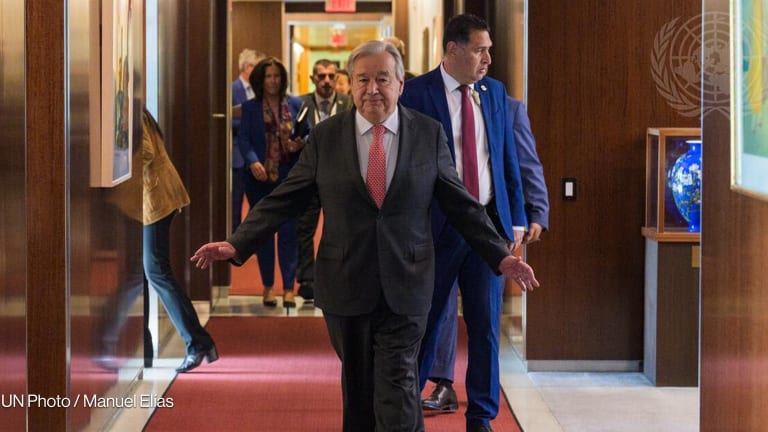
UNITED NATIONS — As United Nations Secretary-General Antonio Guterres moves to make good on a decades-old commitment of gender parity, some U.N. observers and staff representatives are questioning the way the potentially transformative, system-wide strategy is being carried out.
Guterres aims to reach gender parity at senior leadership levels — meaning all under secretary-general and assistant secretary-general positions — by 2021, and achieve parity across the entire U.N. system “well before 2030,” according to the system-wide strategy plan released in mid-September.
The U.N. has long maintained an inverse relationship between women’s representation and seniority. In December 2015, while women filled 57.5 percent of the lower level posts, called P-2, they made up just 27.3 percent of the senior level posts, dubbed UG.
"On an aggregate, we are pretty good as an organization. The problem is when you look at the different parts of the house. There is an inverse relationship between seniority and women’s representation. And that in itself is problematic, because it sends a message about women’s role in the system,” explained Nahla Valji, a senior gender advisor with Guterres’ executive office, and the author of the report.
“The second problem is when you start looking at locations, so our numbers are starkly different ... at headquarter location versus the field. Those are the things the strategy was seeking to address. The secretariat is also further behind than the rest of the system.”
Guterres’ office is now working with all U.N. entities to understand their starting points as they develop individual parity strategies. It’s an effort considered necessary for the entire U.N.’s “efficiency, impact, and credibility,” according to the report.
As of December 31, 2015, only five U.N. entities had achieved or exceeded overall gender parity at professional levels or higher, the strategy document shows. They were UN Women, the International Court of Justice, UNAIDS, UNESCO, and the World Tourism Organization (UNWTO). UNAIDS, with a gender action plan, increased its percentage of female heads of country offices from 23 percent to 48 percent between March 2013 and June 2017.
Meanwhile, Guterres’ team has been fielding questions about accurately accounting for staff retention and retirement rates in the coming years. U.N. staff unions have publicly voiced concerns about whether the executive office is correctly projecting the shift in the retirement rate, from 1.9 percent to 0.4 percent, from January 2018 to the mid-2020s. Guterres’ team enlisted the support of a dedicated working group, run by the Office of Human Resources Management, to produce the data in the report.
“It’s very initial maths, but we are not sure the models were tested, and that is the concern we have had. We want to be at 50-50 by 2026, but how do you get there when you look at the math? It is not clear if that is possible,” said Ian Richards, the Geneva-based president of the Coordinating Committee for International Staff Unions and Associations.
Since he began his term as U.N. chief in January 2017, Guterres has appointed women to various senior posts, including Deputy Secretary-General Amina Mohammed. Women now represent 44 percent of senior secretariat posts, an increase from 29 percent since late 2016.
Guterres’ executive team recognizes that its goal cannot be met at the current rate of change but believes it can be achieved if new action is taken.
“Those targets are really tough, there is no question about it, especially with the organizations that have historically had a hard time attracting and promoting women. And it does mean that a huge amount of extra effort is going to go into making sure that women apply for posts, and making sure there is no gender bias in the shortlisting that has them excluded from final shortlists before the interview. That is going to take a big effort,” said Anne Marie Goetz, a professor at New York University’s Center for Global Affairs and the former chief advisor on peace and security at UN Women.
In 1996, the U.N. first committed to gender parity for managerial and decision-making posts by 2000, marking the start of what former U.N. official Karin Landgren has called a “lost agenda.”
This new accountability plan comes with Guterres’ multi-phased schedule for implementation. Heads of departments and missions must confirm by June 2018 if their entity is on track with the strategy. If not, the U.N. will offer “targeted support.” If still off track by December 2018, heads of offices and departments will receive a warning. If offices or departments continue to not reach benchmarks, their senior USG-level selections will be revoked as of December 2019. Continued lack of action will result in Guterres himself reviewing the appointments.
All staff with hiring responsibility will need to personally sign off on “departmental statistical status on gender parity” before making a final decision on a candidate. And the U.N. Secretariat is developing a public website to track the demographics of its workforce.
The strategy also addresses some of the underlying issues — such as inequitable parental leave policies and inflexible work options — that could influence some women to leave the U.N. or reconsider advancing their careers there. A 2016 an Impactpool study of present and former U.N. staffers showed that women who left the U.N. saw their careers progress more than those who remained.
However, the strategy does not address other workplace challenges, some of which are specific to the U.N.’s set-up, Goetz pointed out. For example, the “amazingly generous package” of benefits that the U.N. offers nonetheless excludes the cost of childcare from birth to the age of 5.
“It shows that the U.N. has a male staff member in mind when designing benefits,” she said.
Some people in the U.N. also raised concerns during consultations that the promotion of women would somehow “lessen standards rather than raise them,” the report notes. That claim has been refuted by evidence, the report adds. And Guterres’ executive office has noted that the phrase “qualified women are encouraged to apply,” sometimes evoked by HR representatives, would never be qualified in the same way when referring to men.
Concerns like this are not uncommon in countries that have imposed quota systems for gender parity in their parliaments, said Jean Krasno, a political science professor at The City College of New York and an organizer of WomanSG, a group that pushed for female secretary-general candidates and senior women officials in Guterres’ office.
“Where this is new and something that isn't the culture, of course there is going to be pushback. If you [have] always been in a position of privilege, you don't like to give it up,” she said.
Read more Devex coverage on gender equality.








